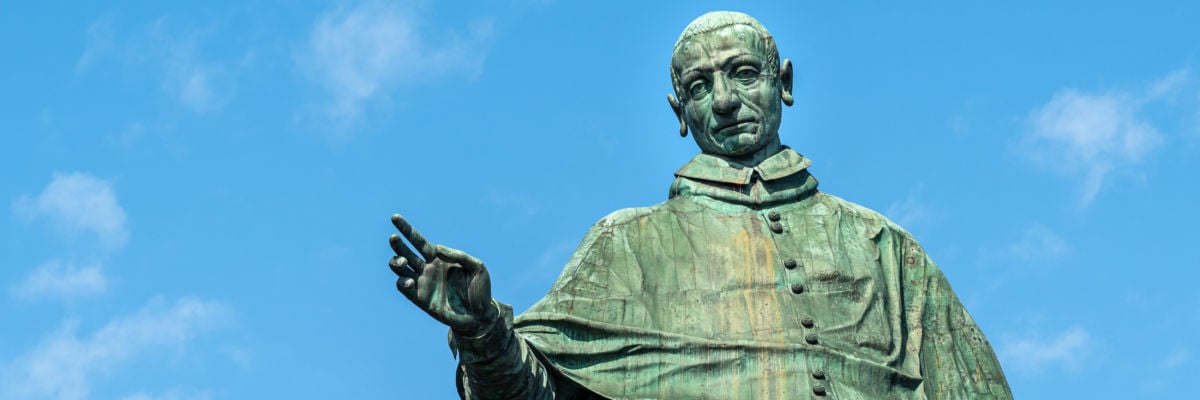
In the bestselling interview with Vittorio Messori, Cardinal Joseph Ratzinger expressed his great admiration for a 16th-century cardinal and archbishop of Milan as a model of authentic reform and renewal in the Church. The future pope declared:
For me, Charles Borromeo is the classic expression of a real reform, that is to say, of a renewal that leads forward precisely because it teaches how to live the permanent values in a new way, bearing in mind the totality of the Christian faith and the totality of man . . . he was totally centered on Christ. (The Ratzinger Report, 38-39)
A saint, reformer, cardinal, apologist, archbishop, and tireless pastor, St. Charles Borromeo rebuilt the Church in Milan during the 16th century and was one of the greatest figures of the Catholic Reformation. For Catholics laboring to renew the Church today in the face of a hostile culture, Borromeo stands as a champion of authentic renewal, as a gentle but determined saint, and as a powerful spokesman for the reinvigoration of the priesthood through zeal, commitment to the truth, and attracting solid, faithful seminarians. Above all, he is a reason for Catholics today to embrace the Catholic Reformation and the heroic men and women who led it.
Powerful Connections
Born into Italian nobility on October 2, 1538, Charles Borromeo was the son of Giberto II Borromeo and Margherita de’ Medici. Thus, through his mother, young Carlo was related to the powerful de’ Medici family that was ascendant in Renaissance Italy. This connection proved a significant one, both for Charles and for the Church.
Entering into Church service at the age of 12, young Charles was sent away from home to study Latin and then began the long task of mastering Scholastic theology. Overcoming an early stutter, he went to Pavia in 1558 and met his uncle, Cardinal Giovanni Angelo de’ Medici, who was impressed with the young man. A few weeks later Charles’ father died at Milan. Despite his age, Charles was asked by the family to assume direction over all of its many responsibilities and interests. Incredibly, even in the midst of the ceaseless demands on his time, he finished in 1559 the double doctorate (utroque iure (doctorates in both civil and canon law).
That same summer, the death of Pope Paul IV brought the cardinals to Rome for a conclave. Cardinal de’ Medici was elected pope in December, taking the name Pius IV. Shortly after the start of the new year, Charles was summoned to Rome, appointed administrator of the Papal States, and in short order a cardinal-deacon. This was, of course, a case of nepotism, but the pontiff was not engaging in corruption or favoritism. He had recognized Charles’ talent and wanted him in the papal court. One other appointment proved significant—Charles was named administrator of the vacant Archdiocese of Milan, and on February 8, 1560, Pius asked him to serve officially as its archbishop.
The Cardinal Becomes a Priest
At 22, Charles was now one of the most powerful figures in the new papal court. Aside from his crushing duties for the pope, Charles was concerned with Catholic education and the continuation of authentic renewal for the Church. He founded the Almo Collegio Borromeo and an academy at the Vatican dedicated to literature. Owing to the lateness of its gatherings, the fruits of its labors became known as the (Noctes Vaticanae (“Vatican Nights”).
Far more challenging was the often thankless task of trying to re-start the Council of Trent that had not gathered since 1552, as Pope Paul IV had decided to continue the reform on his own initiative. Charles used all of his diplomatic skills to cajole Philip II of Spain, the German Catholic princes, and the French to take part. At last, in 1562 the council reconvened. Once more, Charles was instrumental in holding the fragile coalition of representatives together long enough for the council to complete its work. The 25th and final session of Trent was held in December 1563. The decrees of the council were confirmed on January 26, 1564 by Pius IV. Charles next played a key role in drafting the famed Roman Catechism and establishing the Confraternity of Christian Doctrine (CCD).
Even as the Catholic Reform advanced with Charles’ help, the young cardinal was confronted by new pressures. In November 1562, Charles’ older brother, Count Federigo, died, and the family pressured him to abandon his work for the Church and assume the full-time direction of the family’s many interests. At the behest of Charles’ mother (the pope’s sister), Pius IV himself suggested to Charles that he depart Rome.
Charles, however, was undergoing a personal conversion and now labored to renew himself with the same zeal that he brought to the reform of the Church. He had abandoned worldly pursuits slowly over the years, and to make it truly manifest, Charles received permission to be ordained a priest in the magnificent basilica of Santa Maria Maggiore in Rome, on September 4, 1563. He joyously celebrated his first Mass on the Assumption, in St. Peter’s Basilica. His decision was now final—he would live and die for Christ alone. On December 7, 1563, the feast of St. Ambrose, he was consecrated a bishop in the Sistine Chapel.
In December 1565, the popular Pope Pius IV died in Rome. Charles, as a cardinal, took part in the conclave to choose his successor. Determined to elect a pope who would carry forward the reform of the Church, Charles circumvented any schemes by European Catholic powers to influence the vote and greeted with pleasure the election of the Dominican Cardinal Antonio-Michele Ghislieri on January 7, 1566, who took the name Pius V and who would eventually be proclaimed a saint by the Church.
Borromeo Cleans Up the See
Charles had been faithful in his work for the needs of the Universal Church. But as archbishop of Milan, he desired also to serve the faithful. The largest diocese in the world at the time, the see of Milan had been vacant for several years and without a resident archbishop for nearly eight decades when Charles was named to the post. Milan suffered the absences of decisive leadership, clerical discipline, liturgical vitality, and true lay spirituality. The archbishop set about the task ahead of him with the same fervor that had accompanied his work at Trent, but the Milanese problems were deeply ingrained. Over the next years, the crisis of faith in the city became an often grim challenge as he faced opposition from many quarters and even plots of assassination.
One of the first efforts Charles made as archbishop was to restore some semblance of liturgical order. This he accomplished by making pastoral visits to the most disorganized and unruly of his parishes, and over time his visits became a permanent feature of his episcopacy. He paid particular attention to his own cathedral and its chapter. He was adamant that his priests should be committed to their vows and should be examples for the faithful. When they were not, he was just as determined that they should be removed from priestly service. (Such was the case with his own Jesuit confessor, who had engaged in sexual impropriety.) Shocked by the lax spirituality of his own priests, not to mention their theological and pastoral ignorance, the archbishop focused on proper priestly formation. He founded colleges, seminaries, and other institutions for training new priests.
Charles was bitterly opposed by many priests and religious and secular leaders who fell under attack for their corruption and vices. His opponents soon accused him of interfering in affairs beyond his proper jurisdiction and sent letters of complaint to the papal court. Not surprisingly, these found a poor reception in Rome.
Charged by Pope Pius with investigating and reforming the Humiliati, a community of brothers whose practices had grown lax, Charles proved so intent on his task that several members schemed for his murder. The plot nearly succeeded. Charles forgave his attackers, but the would-be assassins were executed by the civil authorities and the order suppressed.
Totally Centered on Christ
Five years later, Milan was ravaged by the plague. Charles was indefatigable in leading the city through this terrible crisis. While Milan’s leadership fled for their lives, he opened the episcopal palace to the sick, nursed the victims with his own hands, gave the last rites, helped to bury the dead, and consoled the survivors. He also fiercely demanded that his priests follow his example.
Charles spent his last years firmly attached to his diocese until finally dying from sheer exhaustion. When his death at the age of 46 on November 3, 1584, was announced to Pope Gregory XIII, the pontiff cried out, “A light has been extinguished in Israel!” His death brought a wave of sorrow in the city and immediate calls for his canonization. On November 1, 1610, Pope Paul V did so. Charles Borromeo’s feast day is celebrated on November 4. Contrary to his wishes, the grateful Milanese gave him an ornate crypt in the Duomo, and his nephew, Federico Borromeo (archbishop of Milan from 1595 to his death in 1631) commissioned a statue. The colossal memorial was completed by Giovanni Battista Crespi, who also undertook a series of paintings in the Duomo, the so-called (Quadroni, two cycles on Charles’ life and miracles as archbishop.
For Catholics everywhere, Charles Borromeo remains a shield against those who argue the Catholic Reform touched few daily lives and that the leaders of that reform were more concerned with hunting down heretics than proclaiming Christ. Cardinal Ratzinger offers the secret of why this is false and why Borromeo’s legacy is worth our study:
Charles could convince others because he himself was a man of conviction. He was able to exist with his certitudes amid the contradictions of his time because he lived them. And he could live them because he was a Christian in the deepest sense of the word; in other words, he was totally centered on Christ. What truly counts is to reestablish this all-embracing relation to Christ. No one can be convinced of this all-embracing relationship to Christ through argumentation alone. One can live it, however, and thereby make it credible to others and invite others to share it. (The Ratzinger Report, 39)



